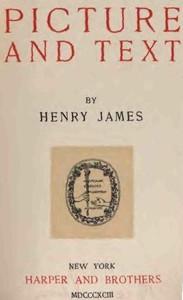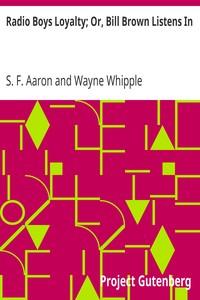|
|
Read this ebook for free! No credit card needed, absolutely nothing to pay.Words: 34586 in 7 pages
This is an ebook sharing website. You can read the uploaded ebooks for free here. No credit cards needed, nothing to pay. If you want to own a digital copy of the ebook, or want to read offline with your favorite ebook-reader, then you can choose to buy and download the ebook. PICTURE AND TEXT BLACK AND WHITE If there be nothing new under the sun there are some things a good deal less old than others. The illustration of books, and even more of magazines, may be said to have been born in our time, so far as variety and abundance are the signs of it; or born, at any rate, the comprehensive, ingenious, sympathetic spirit in which we conceive and practise it. If the centuries are ever arraigned at some bar of justice to answer in regard to what they have given, of good or of bad, to humanity, our interesting age might perhaps do worse than put forth the plea of having contributed a fresh interest in "black and white." The claim may now be made with the more confidence from the very evident circumstance that this interest is far from exhausted. These pages are an excellent place for such an assumption. In Harper they have again and again, as it were, illustrated the illustration, and they constitute for the artist a series of invitations, provocations and opportunities. They may be referred to without arrogance in support of the contention that the limits of this large movement, with all its new and rare refinement, are not yet in sight. In regard, however, to the implications and explications of this perfection of a village, primarily and to be just, Broadway is, more than any one else. Mr. Frank Millet. Mr. Laurence Hutton discovered but Mr. Millet appropriated it: its sweetness was wasted until he began to distil and bottle it. He disinterred the treasure, and with impetuous liberality made us sharers in his fortune. His own work, moreover, betrays him, as well as the gratitude of participants, as I could easily prove if it did not perversely happen that he has commemorated most of his impressions in color. That excludes them from the small space here at my command; otherwise I could testify to the identity of old nooks and old objects, those that constitute both out-of-door and in-door furniture. In such places as Broadway, and it is part of the charm of them to American eyes, the sky looks down on almost as many "things" as the ceiling, and "things" are the joy of the illustrator. Furnished apartments are useful to the artist, but a furnished country is still more to his purpose. A ripe midland English region is a museum of accessories and specimens, and is sure, under any circumstances, to contain the article wanted. This is the great recommendation of Broadway; everything in it is convertible. Even the passing visitor finds himself becoming so; the place has so much character that it rubs off on him, and if in an old garden--an old garden with old gates and old walls and old summer-houses--he lies down on the old grass , it is ten to one but that he will be converted. The little oblong sheaves of blank paper with elastic straps are fluttering all over the place. There is portraiture in the air and composition in the very accidents. Everything is a subject or an effect, a "bit" or a good thing. It is always some kind of day; if it be not one kind it is another. The garden walls, the mossy roofs, the open doorways and brown interiors, the old-fashioned flowers, the bushes in figures, the geese on the green, the patches, the jumbles, the glimpses, the color, the surface, the general complexion of things, have all a value, a reference and an application. If they are a matter of appreciation, that is why the gray-brown houses are perhaps more brown than gray, and more yellow than either. They are various things in turn, according to lights and days and needs. It is a question of color , but the irresponsible profane are not called upon to settle the tint. He began by having an excellent pencil, because as a thoroughly practical man he could not possibly have had a weak one. But nothing is more remunerative to follow than the stages by which "faculty" in general has become the particular faculty; so that if in the artist's present work one recognizes--recognizes even fondly--the national handiness, it is as handiness regenerate and transfigured. The American adaptiveness has become a Dutch finish. The only criticism I have to make is of the preordained paucity of Mr. Millet's drawings; for my mission is not to speak of his work in oils, every year more important , nor to say that it is illustration too--illustration of any old-fashioned song or story that hums in the brain or haunts the memory--nor even to hint that the admirable rendering of the charming old objects with which it deals , the old surfaces and tones, the stuffs and textures, the old mahogany and silver and brass--the old sentiment too, and the old picture-making vision--are in the direct tradition of Terburg and De Hoogh and Metzu. There is no paucity about Mr. Abbey as a virtuoso in black and white, and if one thing more than another sets the seal upon the quality of his work, it is the rare abundance in which it is produced. It is not a frequent thing to find combinations infinite as well as exquisite. Mr. Abbey has so many ideas, and the gates of composition have been opened so wide to him, that we cultivate his company with a mixture of confidence and excitement. The readers of Harper have had for years a great deal of it, and they will easily recognize the feeling I allude to--the expectation of familiarity in variety. The beautiful art and taste, the admirable execution, strike the hour with the same note; but the figure, the scene, is ever a fresh conception. Never was ripe skill less mechanical, and never was the faculty of perpetual evocation less addicted to prudent economies. Mr. Abbey never saves for the next picture, yet the next picture will be as expensive as the last. His whole career has been open to the readers of Harper, so that what they may enjoy on any particular occasion is not only the talent, but a kind of affectionate sense of the history of the talent, That history is, from the beginning, in these pages, and it is one of the most interesting and instructive, just as the talent is one of the richest and the most sympathetic in the art-annals of our generation. I may as well frankly declare that I have such a taste for Mr. Abbey's work that I cannot affect a judicial tone about it. Criticism is appreciation or it is nothing, and an intelligence of the matter in hand is recorded more substantially in a single positive sign of such appreciation than in a volume of sapient objections for objection's sake--the cheapest of all literary commodities. Silence is the perfection of disapproval, and it has the great merit of leaving the value of speech, when the moment comes for it, unimpaired. Accordingly it is important to translate as adequately as possible the positive side of Mr. Abbey's activity. None to-day is more charming, and none helps us more to take the large, joyous, observant, various view of the business of art. He has enlarged the idea of illustration, and he plays with it in a hundred spontaneous, ingenious ways. "Truth and poetry" is the motto legibly stamped upon his pencil-case, for if he has on the one side a singular sense of the familiar, salient, importunate facts of life, on the other they reproduce themselves in his mind in a delightfully qualifying medium. It is this medium that the fond observer must especially envy Mr. Abbey, and that a literary observer will envy him most of all. Even if Mr. Alfred Parsons were not a masterly contributor to the pages of Harper, it would still be almost inevitable to speak of him after speaking of Mr. Abbey, for the definite reason that these gentlemen are united in domestic circumstance as well as associated in the nature of their work. In London, in the relatively lucid air of Campden Hill, they dwell together, and their beautiful studios are side by side. However, there is a reason for commemorating Mr. Parsons' work which has nothing to do with the accidental--the simple fact that that work forms the richest illustration of the English landscape that is offered us to-day. Harper has for a long time past been full of Mr. Alfred Parsons, who has made the dense, fine detail of his native land familiar in far countries, amid scenery of a very different type. This is what the modern illustration can do when the ripeness of the modern sense is brought to it and the wood-cutter plays with difficulties as the brilliant Americans do to-day, following his original at a breakneck pace. An illusion is produced which, in its very completeness, makes one cast an uneasy eye over the dwindling fields that are still left to conquer. Such art as Alfred Parsons'--such an accomplished translation of local aspects, translated in its turn by cunning hands and diffused by a wonderful system of periodicity through vast and remote communities, has, I confess, in a peculiar degree, the effect that so many things have in this age of multiplication--that of suppressing intervals and differences and making the globe seem alarmingly small. Vivid and repeated evocations of English rural things--the meadows and lanes, the sedgy streams, the old orchards and timbered houses, the stout, individual, insular trees, the flowers under the hedge and in it and over it, the sweet rich country seen from the slope, the bend of the unformidable river, the actual romance of the castle against the sky, the place on the hill-side where the gray church begins to peep --all this brings about a terrible displacement of the very objects that make pilgrimage a passion, and hurries forward that ambiguous advantage which I don't envy our grandchildren, that of knowing all about everything in advance, having trotted round the globe annually in the magazines and lost the bloom of personal experience. It is a part of the general abolition of mystery with which we are all so complacently busy today. One would like to retire to another planet with a box of Mr. Parsons' drawings, and be homesick there for the pleasant places they commemorate. The moral of it--I refer to the artistic one--seen altogether, is striking and edifying enough. What Mr. Du Maurier has attempted to do is to give, in a thousand interrelated drawings, a general satiric picture of the social life of his time and country. It is easy to see that through them "an increasing purpose runs;" they all hang together and refer to each other--complete, confirm, correct, illuminate each other. Sometimes they are not satiric: satire is not pure charm, and the artist has allowed himself to "go in" for pure charm. Sometimes he has allowed himself to go in for pure fantasy, so that satire slides off the other side of the runaway horse. But he remains, on the whole, pencil in hand, a wonderfully copious and veracious historian of his age and his civilization. EDWIN A. ABBE Free books android app tbrJar TBR JAR Read Free books online gutenberg More posts by @FreeBooks
: The Range Boss by Seltzer Charles Alden Schoonover Frank E Illustrator - Western stories@FreeBooksWed 07 Jun, 2023

: Radio Boys Loyalty; Or Bill Brown Listens In by Aaron S F Samuel Francis Whipple Wayne - Detective and mystery stories; Kidnapping Juvenile fiction; Radio Juvenile fiction; Marconi Guglielmo marchese 1874-1937 Juvenile fiction Children's Book Series@FreeBooksWed 07 Jun, 2023
|
Terms of Use Stock Market News! © gutenberg.org.in2025 All Rights reserved.






